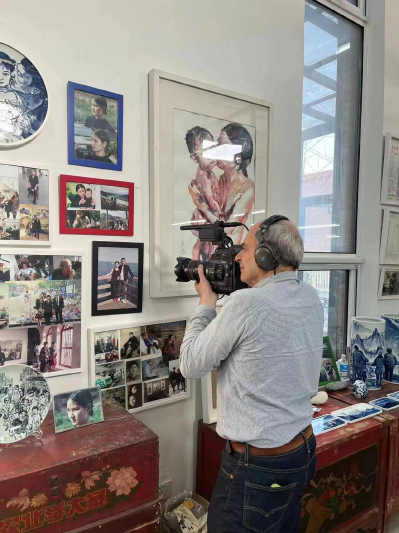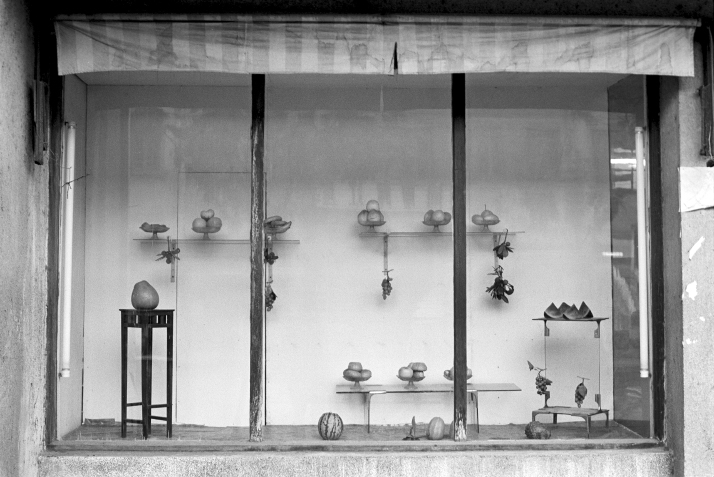| Lifestyle |
| An Italian photographer and filmmaker's works offer windows into China over the last four decades | |
|
|
 Andrea Cavazzuti, an Italian photographer and filmmaker living in China, shoots videos for his latest documentary in Beijing in April 2024 (COURTESY PHOTO)
Drawn by some plastic grapes, peaches and bananas in a shopwindow in downtown Shanghai, Andrea Cavazzuti entered the store with the intention of buying fruit. The year was 1982, four years after China adopted its reform and opening-up policy. But Cavazzuti, then an Italian student learning Chinese in the city, was told the store was out of stock. "Then, why display the plastic fruit in the window?" Cavazzuti, 23 at the time, wondered. It took him four decades of living and working in China to arrive at the answer: Those plastic fruits were carriers of the Chinese people's dream for the future, a future featuring sufficient supplies of food and other goods. With China pursuing its reform and opening-up policy, that dream has since become a reality. The country has even become the biggest fruit producer and consumer in the world. According to China's National Bureau of Statistics, the country produced 327,442,800 tons of fruit in 2023, and every Chinese person had access to 0.64 kg of domestic fruit on average every day. With one fifth of the world's population and less than one 10th of its arable land, China accounts for a quarter of total global grain production. "China is self-reliant in securing its own food supply; its people now not only have enough to eat, but also a greater range of choices, " read a white paper titled "Food Security in China," published by the State Council Information Office of China in October 2019. Cavazzuti doesn't pay much attention to these macroeconomic figures. Instead he has used his cameras to record the changes occurring within Chinese society over the past four decades. "I don't think any country in the world has developed so quickly in such a short time," he told Beijing Review. Windows into China When Cavazzuti first saw China on a map in his late teenage years, he was filled with curiosity. "It was such a big place and I didn't know anything about it," he said. Plus, he was fascinated by the fact that China is one of the few countries in the world that uses characters instead of an alphabet. He learned by chance that Chinese was taught at a university in Venice and traveled to the city to investigate. Nevertheless, there was little introduction to the program, and some people even tried to persuade him not to learn the language as they said he wouldn't be able to actually go to China. But the young Cavazzuti was rebellious. "The more they discouraged me, the more I thought that it was worth doing," he said. After enrolling in the program, Cavazzuti got the opportunity to take a language workshop at Nanjing University in east China for six weeks in the summer of 1981. The next year, he was granted a scholarship to study contemporary Chinese literature at Fudan University in Shanghai, and he graduated in 1984. Between 1981 and 1984, Cavazzuti visited and took pictures of local people in more than 30 cities across China, including Beijing, Shanghai, Suzhou, Qingdao, Xiamen and Sanya. Images of workers, farmers, hairdressers, lovers and kids were all captured by his lenses. "I didn't know anyone in the early 1980s. So I was just passing by and recorded what I saw on the streets: the people and objects," he said. According to American photographer and curator John Szarkowski (1925-2007), there is a fundamental dichotomy between photographers: those who believe that all art is about self-expression and whose photos function as mirrors, and those who see art as a means of exploration, whose photos serve as windows. "I definitely belong to the second category," Cavazzuti said. "Every moment that caught my eyes was something unexpected, something I had never thought about before." What he found most striking was the dress of the Chinese people at that time. "Everybody looked the same because they were dressed the same. It was difficult even to tell an artist from an engineer or a street cleaner. It was different from the West." Cavazzuti and another Italian photographer displayed their photos at an exhibition in Beijing in 1993. And 18 years later, he published his first Chinese photographic collection—At Ease, showcasing some of his black and white photos taken between 1981 and 1984. "The photographic collection records a bygone era, which in fact was significant to Chinese people," Zhi An, a Chinese writer and a friend of Cavazzuti, told Beijing Review. "Cavazzuti was interested in minute changes in Chinese society, capturing ordinary people's minor but happy moments, which may have been ignored by many Chinese photographers."  Plastic fruit on display in a shopwindow in downtown Shanghai in 1982, four years after China adopted its reform and opening-up policy Andrea Cavazzuti, an Italian photographer and filmmaker living in China, shoots footage for his latest documentary in Beijing in April (ANDREA CAVAZZUT)
From shutter clicks to film making After graduating from Fudan University in 1984, Cavazzuti went back to Italy and served in the army for one year. In 1986, he began working for an Italian company aiming to enter the Chinese market, first based in Hong Kong, then in Beijing. His term with the company lasted for 13 years. During this period, he worked as both a photographer and cameraman in his spare time. He interviewed many renowned Chinese writers, including Yu Hua and Wang Xiaobo. He also worked as a director of photography for some Chinese films. "My main interest is always being around photography and then video-making." In 1999, he decided to quit his job with the Italian company and pursued his art dream full-time and wholeheartedly. In recent years, Cavazzuti's lenses have been zoomed on people doing interesting things. For example, he went to Shaanxi and Anhui provinces to record traditional music groups between 2007 and 2008. "Those are valuable music traditions. I tried to record them in their original form, as they are in the places where they originated," he said. His latest documentary is about ordinary Chinese mothers. "They all have a strong desire to talk. It's not anything desperate or particularly sad. But it gives you an idea of how Chinese society is at this moment and the problems they face," Cavazzuti said. A veteran photographer and cameraman focusing on China, Cavazzuti witnessed how Western media's attitudes towards China have changed over the last four decades. "What they do depends a lot on the political mood of the period," he said. In the 1990s, many media said China was developing and it was such a good thing because they thought that in the end China would become like the West. When they found out that China wouldn't become like the West, they started to say bad things about China, he added. "That's what I don't like about journalism. They were saying all these beautiful things several years ago and now everything is bad. It's ridiculous but it influences public opinion," Cavazzuti said. However, he has, at some points, worked with Italian and Swiss media. "I did so because I was trying to make the journalists be more knowledgeable about what they were doing and wanted to give them more varied and interesting perspectives," he said. BR (Print Edition Title: Snapshots of Change) Copyedited by G.P. Wilson Comments to linan@cicgamericas.com |
|
||||||||||||||||||||||||||||
|